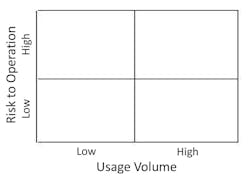SMI Executive briefing on demand planning
by SMI members
In an ideal state, providers across the industry would be able to forecast accurately the supplies that they need for clinical care with great precision and adequate lead time. Suppliers would use these demand signals from across the marketplace to fine tune production and distribution. By minimizing the risk of disruption to the supply chain, sophisticated demand planning can support uninterrupted clinical care delivery at the front lines.
In aspiring toward this state, healthcare must mature as an industry and broadly establish competencies in the fundamentals of demand planning. These industry “must haves” include product category prioritization, data standards, and information sharing between trading partners. While there are pockets of such expertise and activity today, as a whole, the industry has yet to meet the milestones necessary to engage in demand planning at the same level as other industries.
Planning to address spikes in demand starts by determining what are typical purchasing and utilization levels during normal times. With this as a baseline, suppliers can better identify when purchasing or utilization patterns are out of the ordinary. Providers should also attempt to advise suppliers when they anticipate or are experiencing true changes in demand, given that actual need can be obscured when providers place orders with multiple vendors in an attempt to aggregate necessary volumes in the face of allocation.
This executive briefing outlines, in four stages, the fundamentals that healthcare must achieve in order to advance our ability to engage in more advanced demand planning.
Stage 1 – Defining the most critical products
• Purpose: Provides focus to providers and suppliers by defining the most critical products with clear understanding of reason behind criticality.
• Provider Organizations: Plot your 100 most critical items in a grid, such as the one below, based on the volume of the product you use and the risk to your organization. Each organization may develop its own definition of risk, but for the purposes of this exercise, consider multi-dimensional risk including threats to clinical care, revenue, operations, clinical quality, patient and staff experience, etc. The items in the “high volume, high risk” top right box are the highest priority and should command focus in the next 3 stages.
• Supplier Organizations: Gain insight into your customer’s critical products and priorities.
Stage 2 – Speaking a common language across the industry
• Purpose: Enables data synchronization, aggregation, and communication across the industry. Demand data from a single customer is not enough to provide direction for suppliers; they need data from a critical mass of the marketplace to respond effectively.
• Provider Organizations: While item masters today may assign unique local or proprietary product codes, it is imperative to transact data on products using identifiers that are common across the industry. SMI recommends use of the GS1 global trade item number (GTIN), although use of any of the industry standard codes that are compliant with the U.S. FDA’s unique device identification rule will suffice, i.e., the GTIN, HIBCC-LIC or the ICCBBA ISBT-128.
• Supplier Organizations: Assist your customer by helping them gain access to the GTINs for your products.
Stage 3 – Understanding inventory and consumption in real time
• Purpose: Line of sight into inventory levels and consumption rates directly translates into understanding how much you need to order and provides critical information for manufacturing production schedules.
• Provider Organizations: Create real-time visibility into your inventory. Inventory should be digital, and consumption should be real time. This may be a significant shift for some organizations, so focus efforts on your top priority products defined in Stage 1.
• Supplier Organizations: Prepare to receive data from provider organizations and set up systems and processes to review and react to the data.
Stage 4 – Sharing information using data and metrics
• Purpose: Data shared between trading partners will allow demands signals to be identified and used to enable business continuity for both providers and suppliers.
• Provider Organizations: Share data on inventory and consumption via electronic channels with your suppliers on a regular and continuous basis.
• Supplier Organizations: As you aggregate and interpret demand signals across your customer base, provide feedback to the providers regarding your efforts and ability to meet their demand.
Demand shapers
Beyond addressing the fundamental steps above, we recognize that multiple factors exist that shape demand. While these factors cannot stand alone, they can improve the precision of the demand signals generated by provider organizations. As we consider, as an industry, how to best incorporate these into our demand planning rubric, we should also build capabilities for trading partners to share this information.
Internal data sources
• Service Line Planning & Projections
• Anticipated or budgeted volume
• Anticipated consumables associated with capital equipment purchase
• Physician recruitment or departure
• Strategic decisions – what’s being marketed
• Clinical use/Clinician behavior
• Clinical volume - inpatient census and outpatient clinic volume
• Clinical protocols that dictate how product is being used
• Staff behavior relating to use
• Procedural schedule
• Workforce data
External data sources
• School schedules
• Payer/benefits trends
• Population-level claims data
• Search engine data
• Seasonal variation: flu, weather, pollen count, etc.
• Population growth or shrinkage by age group
• Shared inventory at the state and national levels
To accomplish this important change, providers must take positive control of consumption data and forecasts, and then establish methods to communicate information to suppliers for use in improving production schedules and inventory in channel. To do this, we must all speak a common language by utilizing data standards that support aggregation of information to provide critical mass sufficient to support meaningful action by supplier in production planning and channel partners for inventory visibility.
This work will start small but needs to advance to scale into advance planning systems that are capable of managing thousands of SKUs. These advance planning systems will provide data for skilled inventory/demand planners to use in managing the end-to-end supply chain with distribution and manufacturing supply chains.
Authors
Team Leads
• Karen Conway, Global Healthcare Exchange (GHX)
• Tom Harvieux, BJC HealthCare
Project Consultant
• Li Ern Chen, MD, Li Ern Chen, MD, LLC
Contributors
• Jeffrey Bennish, McKesson Corp.
• Peter Brereton, TECSYS
• Eric Cummings, Syft
• Michael DeLuca, Prodigo Solutions Inc.
• Sean Farley, Virginia Mason Medical Center
• Elizabeth Hilla, HIDA
• Jack Koczela, Froedtert Health
• Keith Lohkamp, Workday
• Vicky Lyle, Owens & Minor, Inc.
• Eric McGlade, VPL
• Lori Pilla, Mercy Health System
• Maggie Sartori, Allina Health
• Bill Selles, Spectrum Health System
• Lee Smith, Syft
• Ruben Taborda, J&J Hospital / Distributor SC Solutions
• Nathan Turnipseed, Veteran’s Health Administration
• Donna Van Vlerah, Parkview Health
• Mark Zacur, Owens & Minor, Inc.
• Nancy Anderson, SMI
• Carolyn Huntington, SMI
SMI® All rights reserved. This publication is available at no charge. Contents of this publication may be reused or reproduced, in part or in whole, only with the specific written acknowledgement of the Strategic Marketplace Initiative as the original author, referencing the website www.smisupplychain.com.


